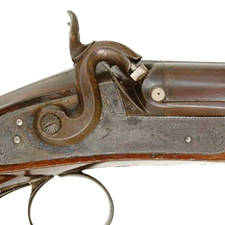- 01: Introduction
- 02: History
- 03: Propellants, Firearms, and Ammunition Development
- 04: Modern Firearms Manufacture
- 05: Small Arms Ammunition
- 06: Evidence Handling Procedures
- 07: Equipment and Instrumentation
- 08: Examination of Firearms
- 09: Cartridge and Shotshell Examination
- 10: Characterization and Evaluation of Fired Projectiles
- 11: Bullet Comparison and Identification
- 12: Gunshot Residue and Distance Determination
- 13: Toolmark Identification
- 14: Communicating Results
- Resources


Percussion Cap
Home > Propellants, Firearms, and Ammunition Development > Evolution of Firearms > Ignition Systems > Percussion Cap

Percussion cap
The ultimate victor in the battle for external chemical priming was the percussion cap. Original caps (circa 1814) were small, soft iron cups with fulminate in the bottom. Later, pewter and soft copper were used for the cups.
To use percussion caps, a firearm required three basic modifications from a classic flintlock. First, an enlarged hollow projection (called the drum or bolster) had to be installed near the vent hole and pan. In most firearms, the drum is integrated with the barrel. Some are fitted with an access port that can be removed to allow for thorough cleaning. The internal passage in the drum typically starts at right angles to the bore and then turns 90° to the rear and approximately 45° upward to meet the hammer.

Firearm modified for percussion cap
The second modification was a removable, replaceable tapered tube (nipple) which screwed into the drum and held the percussion cap. Nipples take direct blows from the hammer and are subjected to high heat and pressure. The tapering of the nipple allowed a snug-fitting cap, keeping it in place during routine gun handling.
The third modification was the transition from the cock to the hammer. The flint clamp was replaced by a one-piece hammer with a nose fitted to directly contact the rear face of the nipple. The surface that contacted the nipple was flat and typically surrounded by extra metal in the form of a skirt, which improved the degree of sealing provided by the percussion system.
These modifications overcame most of the problems of earlier firearm ignition systems. The percussion cap contributed to the sealing of the breech end of the barrel, improving ballistic performance and weatherproofing.
Once a percussion cap was fit onto the nipple, a blow of the hammer would snug the cap even tighter. This could make the spent cap difficult to remove. To counter this effect, some of the sealing properties of the cap were sacrificed. The sidewalls of the percussion cap were ribbed or folded to force the cap to split on firing. This loosened the spent cap on the nipple; little if any effort was required to extract a spent cap. Many simply fell away when the pressure of the hammer was removed.
At this point, improvements to chemical ignition required changes to both arms and ammunition to move the initiator inside the firearm. As will be discussed in the ammunition section, this resulted in a cartridge containing all the components of ammunition—projectile, powder, and primer.




